Samsung Epic 4G Review: The Fastest Android Phone
by Anand Lal Shimpi on September 6, 2010 5:28 PM EST- Posted in
- Smartphones
- Samsung
- Epic 4G
- Gadgets
- Mobile
The Fastest GPU in a Smartphone
One thing I’ve learned over the past several years is that if you’re not the original manufacturer of something and are simply a glorified parts assembler, you generally have no clue how to do something right. There are obvious exceptions (Apple appears to be doing well), but this characterization applies to a lot of companies in the consumer electronics industry. They buy chips and parts from various suppliers, do a little bit of industrial design and generally don’t have the engineering know-how to deliver an optimized product into the marketplace.
Samsung is quite the opposite. Samsung is a DRAM manufacturer, a NAND flash manufacturer, and an application processor manufacturer. Samsung is responsible for the DRAM, NAND and silicon that goes into every iOS device sold by Apple. The company knows a thing or two about engineering.
The SoC inside the Epic 4G and other Galaxy S parts is called Hummingbird. It’s a 45nm SoC that implements a standard ARM Cortex A8 running at 1GHz and a PowerVR SGX 540 GPU. Despite Samsung’s experience in silicon manufacturing, it’s not much of an architecture/design company so we do see a lot of IP licensing within Hummingbird.
In this capacity Samsung is no different than TI, but what really sets Hummingbird apart is its GPU. Licensed from Imagination Technologies, the PowerVR SGX 540 is a significant improvement over the 530/535 in use in the iPhone, iPad and Motorola’s Droid X.
The SGX 530 has two USSE pipes and a single texturing unit. The 535 adds a second texturing unit, and the 540 adds another two USSE pipes. It’s unclear what clock speed the SGX 540 runs at inside Hummingbird, but I’d expect it’s somewhere near the 200MHz of the 535 in TI’s OMAP 3630.
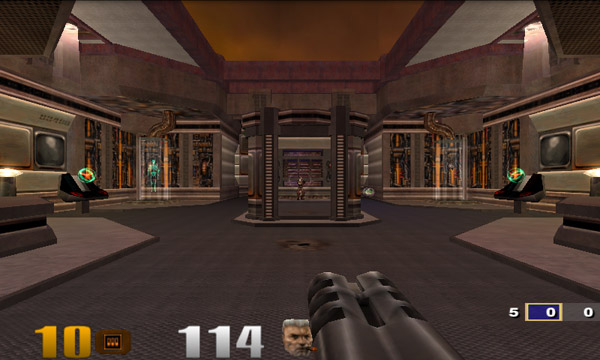
Quake 3 Arena running on the PowerVR SGX 540
The added execution hardware does incur a power penalty, however Imagination lists it as less than double the SGX 535.
The performance improvement is tangible. Samsung’s Hummingbird faster in 3D games/apps than any other SoC used in a smartphone today:
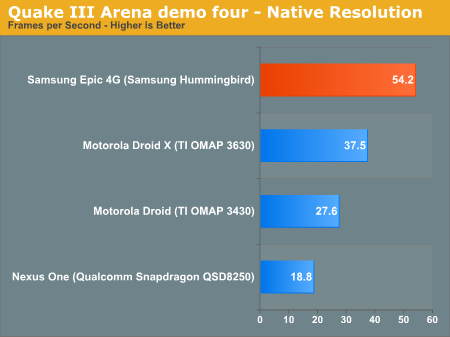
Under Quake III we saw a 44.5% increase in performance over the Droid X. Compared to Qualcomm's Snapdragon, performance improves by nearly 2x.
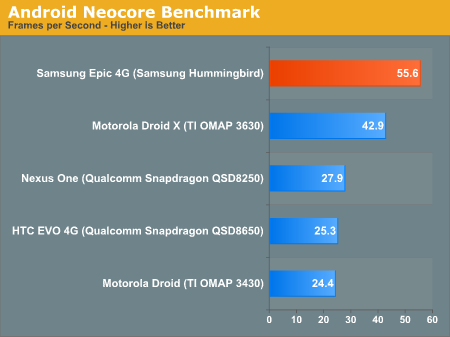
Even in Qualcomm's own 3D test, the PowerVR SGX 540 is more than twice as fast as the Snapdragon. We see a 30% performance advantage over the OMAP 3630. I'd expect to see about the same advantage over Apple's A4.
Unfortunately for Samsung, 3D gaming hasn’t really taken off on Android as a platform. The best examples of what’s to come are what we’ve seen from Epic and id, but both of those demos were done on iOS (although I suspect Android versions would hit at some point) and we’re still pretty far away from having actual games based on those engines on mobile phones.
While the SGX 540 could be responsible for the Epic 4G’s smoother than expected UI, it’s mostly a waste of hardware today. Clearly you don’t need this powerful of a GPU to make scrolling through menus smooth. Perhaps Samsung has grand plans for Hummingbird or simply wanted to outdo the competition on paper. Higher resolution products due out in the future will demand faster GPUs (think tablets) so it’s possible that Hummingbird wasn’t specifically targeted for an 800 x 480 smartphone.
General CPU performance is comparable to the OMAP 3630 and what you’d expect from a 1GHz Cortex A8. The 45nm SoC should sip power but it’s unclear what Samsung is doing for power management on the SoC itself. While both Hummingbird and Apple’s A4 are manufactured at the same fab at 45nm and both use the Cortex A8, there’s a lot more to determine the total power consumption of an SoC.

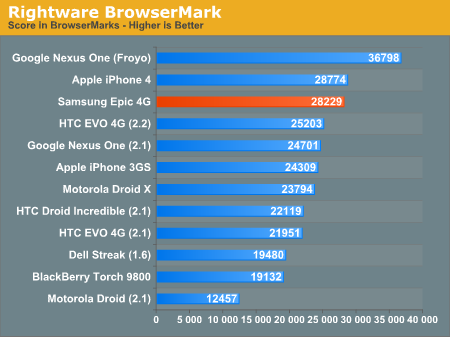
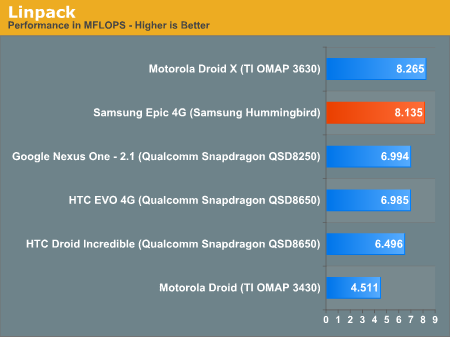
Hummingbird’s memory bus is likely a 32-bit single channel LPDDR1 interface, but overall I’d say it’s safe to say that this is the fastest SoC currently shipping in a smartphone. Apple’s A4 used in the iPhone doesn’t run at 1GHz, and TI’s OMAP3630 uses the PowerVR SGX 530 compared to Samsung’s SGX 540. Unfortunately much of the performance advantage will go unused as 3D gaming simply isn’t that prevalent on Android phones today.










93 Comments
View All Comments
Chaitanya - Tuesday, September 7, 2010 - link
GPS receiver on almost all Samsung phones is bad. Its no surprise that Epic 4G is an epic fail when it came to GPS performance.medi01 - Tuesday, September 7, 2010 - link
The Apple fanboism in anandtech's articles is getting more and more annoying... :("The move to Super AMOLED is key. With Super AMOLED the Epic 4G improves outdoor usability significantly."
To bad we can't see it on the pictures you've made.
Anand Lal Shimpi - Tuesday, September 7, 2010 - link
I believe this shot illustrates the huge improvement over standard AMOLED displays:http://images.anandtech.com/reviews/gadgets/Samsun...
Glare/reflections have been reduced significantly.
Take care,
Anand
pervisanathema - Tuesday, September 7, 2010 - link
noticed this on page 2:"The back cover snaps off with relative ease revealing the 1500mAh battery, a microSD card slow."
I'm sure you mean slot instead of slow. :)
Anand Lal Shimpi - Tuesday, September 7, 2010 - link
Thanks for the correction :)Take care,
Anand
DoubleVanos - Tuesday, September 7, 2010 - link
Battery life seems fine on my AT&T Captivate to be honest. It can easily go on for a full day with a lot of usage. It must be a Sprint thing I guess.MaxMax - Tuesday, September 7, 2010 - link
WTF !I don't know why always Sprint and Verizon gets the best Android phones comparing to T-Mobile and AT&T !!
This one have flash LED while the other galaxy s doesn't !!
Anand Lal Shimpi - Tuesday, September 7, 2010 - link
Haha yep, fixed! Thank you!vision33r - Tuesday, September 7, 2010 - link
There's a very good reason RIM and Apple have lower clocked CPUs, Apple's A4 processor is running only at 60% of it's full clock speed.Battery life.
Remember smartphones are still phones and talk time is more important than mhz.
Most Blackberrys still run under 500MHZ and they do email, web browsing, and light apps just fine.
Why would Android need 1.2GHZ just to run apps? What apps need 1.2GHZ?
That's just not efficient design for mobile apps.
bplewis24 - Tuesday, September 7, 2010 - link
I guess I'm one of the lucky ones. I must own the only Android phone that is just as fast as my girlfriend's iPhone3GS or my colleagues iPhone4 with no more in the way of choppy animations and stuttering than they have.Brandon